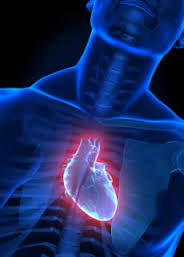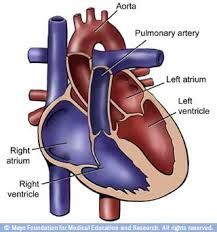Let us first understand how the heart functions. For starters think of a car, without the engine the car won’t move unless pushed in neutral but the engine is still not working at all. Well, the body can’t work at all if the heart isn’t working=dead. Right? We can’t live without the heart but more importantly you can’t function actively and productively with a one that is diseased not cared for or just severely diseased. We need to take good care of our bodies especially if diseased already, that includes your heart.
Looking at the anatomy and physiology of the heart it will help us understand in how it functions. For starters the heart is like the engine of the human body based on its characteristics in that without it we would not be able to function or live; just like a car would not function without an engine. The heart’s anatomy let us start with. In the heart you have chambers (2 on the top called atriums and 2 on the bottom called ventricles), 4 chambers to be exact (sort of like a 4 cylinder car). It also has valves which allows our blood to go in and out of the chambers and vessels of the heart. That is what makes blood move throughout the circulatory system starting from the heart down the abdomen to the arms, than the legs/feet back up to the brain to the heart again. These valves are located before the entrance of the blood entering the heart on right upper chamber, between the upper and lower chambers (atriums & ventricles), at the beginning of arteries and veins involved in moving blood throughout the heart and to or from the lungs to exchange oxygen and carbon dioxide from and into the blood. Lastly, in our veins the legs have valves to push blood back up to the heart because this blood that had high oxygen cells are not filled with more carbon dioxide. When this blood is pushed up in the legs through the veins by valves allowing the blood to return to the heart with more carbon dioxide in the blood this is done to allow that blood to get to the lungs for oxygen and carbon dioxide to transfer (like oil/gas entering the car first in the tank and used throughout the engine and leaves the muffler out the tail pipe (the car’s lungs). Oxygen is our gas to the body without it we couldn’t survive but to get it we have to breath to allow oxygen and carbon dioxide to go in and out of our cells at the bases of the lungs where the blood cells pass by in the circulatory system for the transfer of 02 and CO2 to take place. For this to take place it is when we breath; which is allowing 02 in the body and carbon dioxide (used up oxygen in that cell) to be released from the cell and removed through the lungs on expiration.
Now getting down in how the heart works. First take our blood, in particular our red blood cells are the cells that carry oxygen and carbon dioxide throughout our body; the body without enough oxygen in the body tissues=cellular starvation. We can’t survive without oxygen sent to our tissues=food to our tissues (Ex. poor circulation to any tissue of the body = pain and if not resolved it will go into necrosis = death of the tissue, like in a diabetic that has poor circulation to the toes/foot that has pain/numbness and unresolved = necrosis to amputation). So your blood, in particular the red blood cells, need to transport oxygen (O2) to and take carbon dioxide (CO2) from our tissues in the body and refill up with more 02 and release C02 (O2 used up by our tissues) which takes place at the lungs. This process is done constantly in the body to feed our tissues O2 (by the red blood cells-RBC’s picking up 02 upon inhalation) with tissues releasing CO2 which is picked up by the RBC’s and they take the CO2 to the lungs in releasing it from our body completely via exhaling. This whole process is only done due to the heart beating allowing the blood to circulate and recirculate throughout the body and get more 02 from our lungs (just like the engine of a car in how the engine works to allow fuels, oils to circulate throughout the engine and other areas of the car to allow the car overall to function but when the gas gets low we refill it up at the gas station with more car gas).
In review, our bodies oxygen is the food to our tissues in keeping them alive through our red blood cells (RBC’s) that carry the O2 to the tissues through a working heart and lungs only (one organ cannot live without the other). There has to be a systemic way we allow this to work and this is through the heart, lungs, and RBC’s (3 systems that connect with each other). The heart = right side deals with more C02 blood which is blood returning to the heart to get more 02 going first via the Rt. side of the heart to the Rt. and Lt. pulmonary artery, each of which carries blood to the lungs for 02 and C02 exchange to occur. This is for getting more 02 in our RBC’s with allowing them to release C02 at the lungs and then return them to the left side of the heart to be sent through both Lt. chambers of the heart to our blood stream to utilize the new 02 in our RBC’s to our body tissues. This is a 24hr/7days a week job for our red blood cells, lungs and heart in functioning to keep the human body alive.
In simpler terms this is how it works: The blood that needs to be refreshed with more 02 always enters the right (Rt.) atrium coming from a vessel that brings back mainly carbon dioxide in the blood from the toes and the brain that was mainly used up by the tissues and those RBC’s need to be reoxygenated with higher levels of oxygen for the RBC’s to deliver 02 again to tissues. It first goes to the Rt. atrium & fills up to its max level simultaneously while the left (Lt.) atrium is filling up to its max level. When the Rt. atrium is ready to drop its blood max level into the Rt. ventricle below it the valves open between the chambers simultaneously (the tricuspid valve and mitral valve) dropping the blood to the Rt. Ventricle (Lt side does the same thing) but only the Rt. side ends up going to the lungs through a Rt. and Lt. pulmonary artery to get more oxygen to send the highly oxygenated blood to the L (left) side of the heart. The job the Rt. side of the heart does is this, it just goes from the Rt. side of the heart to our lungs and back to the heart on the Lt. side through the 4 pulmonary veins to the L atrium; so the path or distance for the Rt. side of the heart to do its function is a short distance = it gets your used up oxygen in the red blood cells (that are high in carbon dioxide) to get more oxygen by going through the Rt. side of the heart sending them to the lungs where they get more O2 and then they are sent back to the Lt. side of the heart. This is the Rt. side of the heart’s function and explains why the heart muscle on that side of the heart is smaller than the Lt. side. Now let us look at what the Lt. side of the heart in what it does in its function. The RBC’s reoxygenated that leave the lungs and are sent via the pulmonary vein to the Lt. side of the heart, reaching the Lt. atrium, thus carries a high 02 level in the RBC’s (this blood just came directly from the lungs where O2 and CO2 exchange for the RBC’s took place).
Next the RBC’s go to the Lt. ventricle to our Aorta that sends this high oxygen level of RBC’s out to all our tissues as food to prevent starvation of the tissues. Again, when the valves open between the chambers and allowing this blood to fill up in the lower chambers called the Rt. and Lt. ventricles it is simultaneously done also including the valves that open and close in the heart the pulmonary artery and the aorta that is in the Rt and Lt. The ventricle sending RBC’s out to our circulatory system high in O2 to be utilized by our body tissues is the Lt. Ventrilcle. To do this job takes more effort as opposed to the Rt. Side of the heart and that is why the Lt side of the heart has a bigger muscle mass (more of a work out for the heart).
So the way it works with both sides of the heart is the Rt. side sends blood of highly carbon dioxide blood (RBC’s) to the lungs to get re-oxygenated through 2 vessels from the Rt. side of the heart to the lungs that sends this re-oxygenated blood in the RBC’s through 4 vessels to the Lt. side of the heart and it reaches the Lt. side of the heart which sends this highly oxygenated blood throughout the top and bottom of the Lt. side of the heart to the aorta that sends this blood throughout our body tissues. When this oxygen is used all up from the RBC’s dispensing it out to tissues the C02 is taken back from the tissues by RBC’s that replace it with O2 through breathing, this process starts all over again with these RBC’s that returned to the heart. Ending line the right side of the heart is for higher levels of carbon dioxide in the blood (used up blood) to get more oxygen whereas the left side of the heart sends higher levels of O2 throughout the body all the way to the toes (a harder job=muscle mass of the left side of the heart works out more than the right making the left side of the heart a bigger muscle vs the right side).
Now knowing the anatomy and physiology of the heart let’s now understand more about a cardiac disease RVR=Rapid Ventricular Rate and Atrial Fibrillation and more regarding how they develop and in how it effects the engine of the body, being the heart, and the lungs, the transmission of the body. Like a car if the engine is affected in time the transmission gets affected and if not repaired by the mechanic the car engine will die with the transmission. Same effect with the human engine=the heart. If the heart is affected in time it will effect the lungs and if not repaired the heart will die and so will the lungs.

